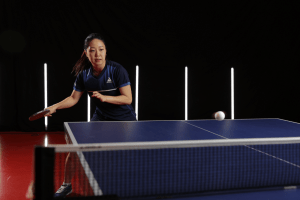What’s the first thing you think of when it comes to how professional table tennis players train? Often times, people only recognize training as how many hours spent practicing on the table or at the court. In reality, training on the table only scratches the surface of being a top athlete. The iceberg underneath reveals a whole plethora of other training approaches, including but not limited to, physical training, mental work, nutrition, match analysis, etc. In this article, we’re going to be picking apart only one area of these training methods – match analysis. This manner of training is absolutely crucial to identifying weaknesses and strengths of both yourself and the opponent, subsequently allowing you to incorporate it into practice on the table and improve your overall game.
When you watch a match, there are several elements to consider – technical, tactical, and psychological. Technical factors refer to specific movements your body makes in order to achieve a desired outcome. It’s the fundamentals and basics of each sport. In table tennis, these can comprise of footwork, stroke, stance, serve, and receive. For example, if you really want to improve your backhand underspin loop, you can watch closely each time the stroke occurs during the match. Slow down the video in order to really be able to see every aspect of the technical stroke involved. Watch for the ready position of your feet and body, the angle of your paddle, the backstroke, the contact of the ball on the paddle, and the follow through. Take note of these technical features and create specific drills/exercises in training on the table to correct them.
Once you create a plan to incorporate those technical skills in practice, you can move on to analyzing the tactical elements of the game. These elements refer to actually applying the technical skills you’ve learned in practice to formulating strategic decisions during a real game or match. Anyone can work hard in practice and perfect every technical ability under the sun, but the capability of a player to maneuver and judge what to do during high pressure moments makes all the difference in the end. Since table tennis is a dynamic sport, the game requires your own tactical performance just as much as the opponent standing across the table.
Several factors to keep an eye out for when you’re analyzing your own tactical game is your spin, depth of the ball, placement, timing variations, and speed. Determine what common factors win the most points for you in the match and try to keep recreating that in the future. Is your backhand your technical strength? If that’s the case, try to figure out which serves or receiving patterns influence your opponent to aim their shots into your backhand. For instance, serving with a forehand pendulum might cause the opponent to receive with the spin, meaning the ball will likely be returned to your backhand. Or maybe learning a backhand serve allows you to adopt a stance that’s more devoted to playing the third ball with your backhand. While understanding your tactical strengths is essential, be aware of your own tactical weaknesses as well. Maybe you notice while studying a match that you tend to stick to one speed during rallies, which might be useful against opponents who don’t prefer that speed but will likely backfire against most high-level players who can easily adjust. Try to vary the speed, the timing, the rhythm and be conscious of that in future matches.
If you’re focusing on tactically analyzing your opponent, the first thing to note is their general style of play. Are they more of an offensive attacker that likes to go for broke on the third ball? Or do they tend to back away from the table and take on a more defensive stance in blocking and placing the ball? Once you’ve determined their typical patterns, watch for their serves. The first three balls of each rally, particularly the serve and receive, hold extra weight to consider when analyzing matches, as it often determines the pace of the rallies and entire game. Try to see which serves your opponent prefers to use and the way they use the serve to set up the next ball. Look for the varying spins, depth (short, half-long, or long), speed, and placement. Then create a plan devoted to how you might return each serve, whether that’s making the next few balls in the rally easier to return for you or receiving it in a manner that creates discomfort for your opponent. Once the game progresses into open rallies, try to determine your opponent’s tendencies, as well as their weaknesses. For instance, they might tend to play only cross court on their forehand, which you can be more aware of and prepared for during a rally. Or, they might have trouble with their footwork going from middle to forehand which you can easily target as well.
Last but absolutely not least, evaluating the subtle psychological elements in a match is much more significant than what many people think. There are countless evenly matched players in a match, both technically and tactically. However, the result of the match often comes down to psychological discrepancies between opponents – how much mental toughness each player has, the way they handle pressure, their body language on display. When you analyze a video, you can watch how both you and your opponent react to certain moments in the match. Maybe their body language becomes dejected and defeated after losing several points in a row and that might be the perfect time for you to go more on the offensive. Nonverbal communication could just be the key to converting match point.
Match analysis might not be as interesting or fun as spending time training on the table, but it is essential to developing a deeper understanding of the game. When you’re competing in a match, it’s almost impossible to determine everything you need to develop because you’re far too close to it. Spending the time to re-watch and study allows you to take on an objective lens to the game and see the exact areas that you need to work on, technically, tactically, and psychologically.




